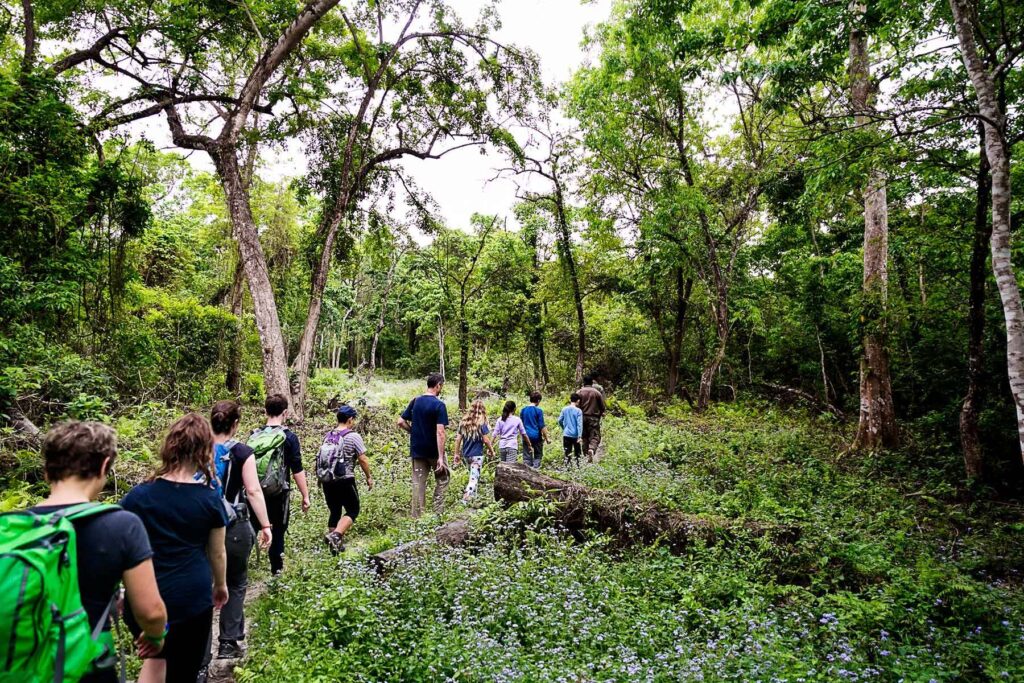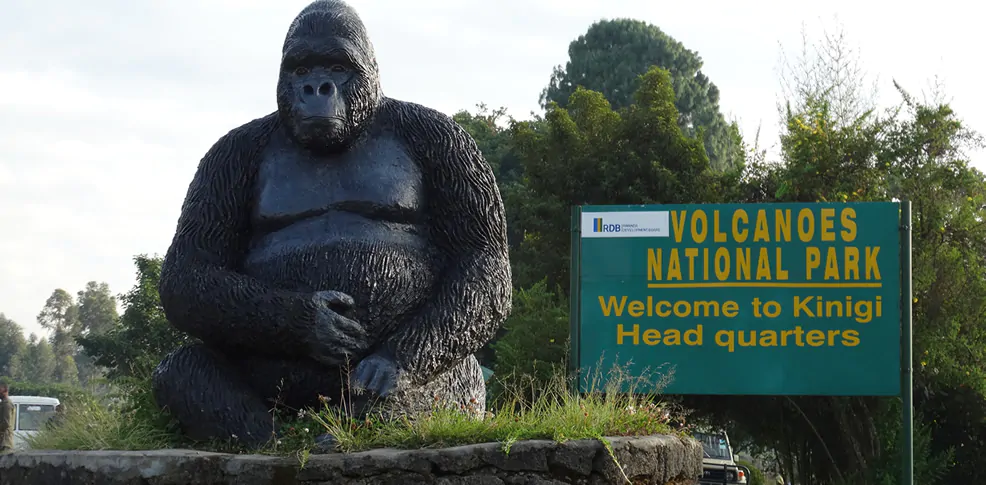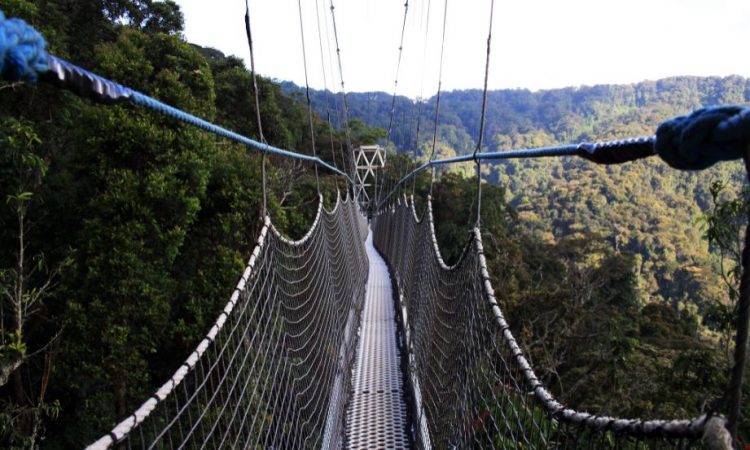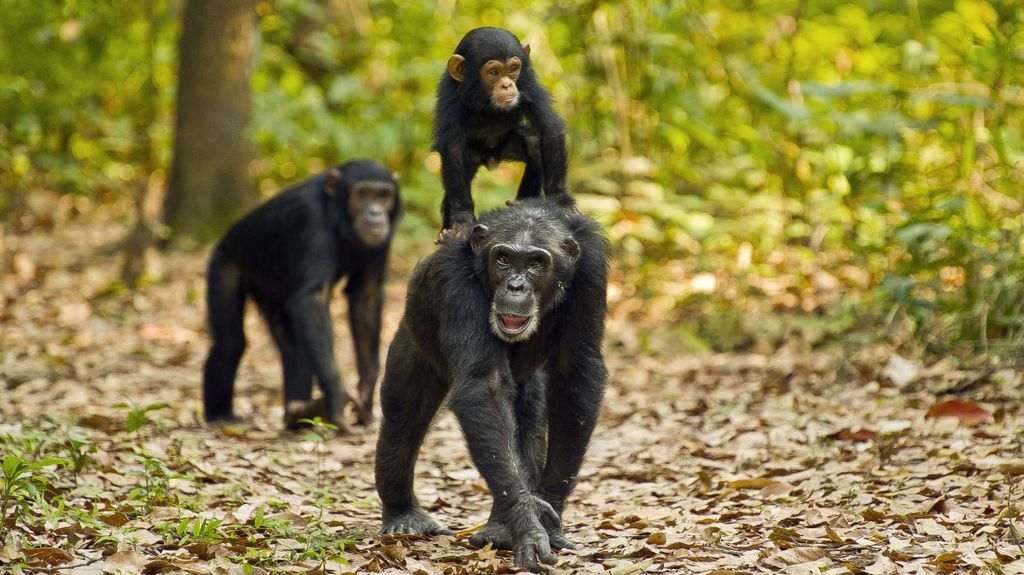List Of Rwanda National Parks
List of Rwanda National Parks: The national parks in Rwanda are listed here. Reliable travel guide written by native Rwandans that helps travelers plan a safari in Rwanda, the “Land of a Thousand Hills,” and gives reliable information to guests from Rwanda. Find details about all of Rwanda’s national parks, lodging options (hotels and safari lodges), ecotourism destinations, driving distances, directions, vehicle rental locations, and much more. The Rwanda Development Board (RDB), which is in charge of maintaining Rwanda’s wildlife, guards all of the country’s national parks.

Volcanoes National Park.
Rwanda’s Volcanoes National Park is the top national park on the list. Situated in the northern region of Rwanda, this area spans 160 square kilometers and is home to the critically endangered mountain gorillas. The ecological zones vary, ranging from lowland forests to afro alpine forests at elevations between 2,400 and 4,500 meters above sea level.
Three nations share the Rwandan portion of the larger Virunga Mountains: Rwanda, Uganda, and the Democratic Republic of the Congo. With over 500 distinct species found in Volcanoes National Park, the Virunga massif is home to the only remaining population of mountain gorillas in the world, making Rwanda possibly the best place in Africa for a tracking safari. In addition to mountain gorillas, the forest is home to a wide range of animals, including the seldom observed forest elephant, black-faced duiker, bush bucks, pigs, buffalo, spotted hyenas, massive forest hog, and other primates including golden monkeys.

A trip to the Volcanoes National Park to see gorillas is an unforgettable outdoor experience that will change your life. Virunga’s location in the Albertine Mountains and its deep forests provide eco-tourists with a unique environment. The park is well-known for the endemic bird species of the Albertine Rift. Of the 178 bird species recorded in the park, 29 are found only in the Albertine Rift Zone.
The forest was first gazetted in 1925 as a small area encircled by the thickly populated districts of Mikeno, Karisimbi, and Visoke in order to keep poachers away from the critically endangered mountain gorillas. After that year, in 1967, the park served as the basis for the establishment of a gorilla study facility at Karisimbi by renowned American biologist Dian Fossey.
Despite conservation efforts to save mountain gorillas, the park was turned into a battlefield during the Rwandan civil war in the 1990s, which resulted in mass killings that killed thousands of people and drastically decreased the gorilla population. As a result, tourists left the park.
Up until 1999, when the park was declared safe for visitors under the Rwandan army’s protection, all operations were suspended. This led to the revival of Rwandan gorilla tourism. In an effort to enhance conservation and gorilla tours in Volcanoes National Park, Rwanda started the annual gorilla naming ceremony for baby gorillas known as “Kwita Iziina” in 2005. This initiative has paid off handsomely in terms of increased gorilla numbers in Volcanoes National Park.
Directions to Volcanoes National Park.
The national park is conveniently reachable by public transportation from Gisenyi town or Kigali, Rwanda, and is situated close to Musanze, formerly known as Ruhengeri. As the park is only two hours’ drive from Gisenyi or Kigali, travelers with limited time can choose to follow the gorillas and return to Kigali the same day. Treks start at 6:00 a.m. from the Kinigi park headquarters, so if you plan to trek for a single day, you must rise early to ensure you there on time.
Nyungwe Forest National Park.

One of Africa’s last surviving intact mountain rain forests, Nyungwe Forest National Park is situated in the southwest province of Rwanda and spans around 1,020 km2 of unspoiled rain forest. It is known for its deep canopy and perpetual green color. Nyungwe Forest, Rwanda’s largest protected region with high altitude rain forest, was declared a national park in 2004 as part of an effort to diversify the country’s tourism industry beyond the well-known mountain gorillas. It was essential given the massive and exquisite biodiversity associated with the Albertine Rift montane forests makes the forest Rwanda’s greatest water reservoir.
With multiple mountain ranges rising from the Lendu plateau in the Democratic Republic of the Congo and passing through the Rwenzori highlands to the Southern shores of Lake Tanganyika, Nyungwe is one of Africa’s most endemic rich ecoregions. One of the best ways to see the world’s most stunning lush, green, mist-covered, untouched rain forest is to go through the forest.
With more than 200 different types of forest, one can see some of the oldest and tallest trees in Africa, including mahoganies, ebonies covered in massive tree ferns, orchids, lobelias with their ephemeral blooms, and many climbing plant species that soar up to 50 meters deep in the rain forest. The exhilarating, unmistakable sound of Africa’s deep tropical rain forest, filled with a vast array of bird species, will reward you for strolling peacefully through the cool forest and taking in the breathtakingly beautiful butterflies.
The park is traversed by a paved road that connects Butare and Lake Kivu, and the forest is alive with a rich array of vegetation and animals. Over five hundred chimpanzees, the nearest relative to humans, live in Nyungwe Forest. Among the largest animals in Nyungwe Forest National Park, monkeys are incredibly well-represented. There are 13 species of monkeys known, making over 25% of the African primate checklist. As the only place in Africa where over 300 colobus monkey armies have been sighted, it is a primatologist’s dream vacation.
With five or six species likely to be spotted on a single afternoon stroll, the Nyungwe forest boasts the highest primate variety and density in all of East Africa. Among the primate species are the stunning L’hoest monkeys, the endearing acrobatic colobus monkeys that are often seen from woodland walks, grey-cheeked mangabeys, red-tailed monkeys, and olive baboons.
Even though Rwanda is home to a diverse range of bird species, each birder’s schedule should visit a few key locations. The forest is home to about 300 bird species, including about 27 endemic species to the Albertine Rift, which makes it a comprehensive birding destination for dedicated ornithologists. The forest’s diverse network of hiking trails passes through several waterfall locations, making it possible for you to go on specialized birding tours and see the captivating array of forest specialists, such as the iridescent sun birds, the psychedelic Rwenzori Turaco, forest buzzards, olive pigeons, and wood hoopoes.
Akagera National Park.
Akagera National Park offers wildlife enthusiasts an amazing chance to witness Rwanda’s biodiversity. It spans Rwanda’s northwest border with Tanzania and consists of a network of lakes surrounded by forests, papyrus swamps, savannah plains, and rolling hills.
When the park was first established in 1934, a large portion of its land was given over to agriculture. As a result, the park’s original size of 25,000 square kilometers was subsequently reduced to 1,122 square kilometers by African National Parks. Even though a large portion of the largest savannah grazing region is now beyond the park’s boundaries, East and Central Africa still has the most beautiful and diverse ecosystem.
One of Africa’s largest protected wetlands, the Akagera River flows along the park’s Eastern perimeter and empties into several lakes entwined with papyrus swamps, inspiring the park’s name. Large mammals and swamp endemic species, like Sitatunga, are well-known in Rwanda’s most popular wetland safari destination. These animals live in the water-logged, forest-fringed lakes along the meandering Akagera river, the steep-sided shores, small undulating rolling hills dotted with papyrus swamps, and savannah plains.
Numerous antelope species, including the elusive eland, topi, and other antelopes like duikers, oribi, klipspringer, bush buck, and the handsome chest-nut coated impalas, as well as swamp endemic species of sitatunga, call this area home. Big game mammals that call it home include buffalos, elephants, giraffes, zebras, and waterbucks. With over 500 different species of birds, including rare swamp endemics like the shoebill stork and other dense populations of water birds in the marsh, Akagera National Park in Rwanda is a noteworthy birding paradise. List of National Parks in Rwanda
In an effort to regain Akagera’s big five status, Transvaal lions have been reintroduced from South Africa, making them the first of their kind to be done so in 15 years. Other resident predators include spotted hyenas, side-striped jackals, and leopards. A project to bring back black rhinos, which were once hunted to extinction, seems to be underway.
In addition to the captivating stretches of thorny acacia woodlands and open savannah teeming with herds of elephants, buffalos, and antelope that one tends to associate with equatorial East Africa, the Akagera River offers a typical African savannah landscape of acacia woodlands. Camping alongside the shimmering attractive lakes of Akagera heaving with aquatic life is a truly mystical introduction to wonders of the African bush. List of National Parks in Rwanda.
Encounters with pods of more than fifty hippos, gape-mouthed crocodiles silently observing prey, and some of the monarchs of African waterways—African Fish eagles—lining the lakes and their amazing aerial displays during a boat ride are among the many sights to behold along the shores of forest-fringed lakes that duet with two connecting marshes. List of National Parks in Rwanda
To the North and Northeast of the park is the mutara, a natural and historic zone with remnants of past pastoral habitation. As one of Africa’s most beautiful and sought-after reserves with a high degree of biodiversity, Akagera National Park is made up of a hill region with gentle slopes, depressions scattered with lakes, the Permanent River, floating plants, and a mosaic of different rich soils.
The Gishwati-Mukura National Park
Gishwati Mukura National Park, tucked away in Rwanda’s West, is a lesser-known but no less fascinating location. The establishment of Gishwati-Mukura National Park, the most recent national park in Rwanda, demonstrates the nation’s dedication to conservation. This park, which is in Rwanda’s northwest, is home to a wide variety of animals and serves as a crucial refuge for endangered species.
Witnessing the rehabilitation of a degraded forest ecosystem is a rare opportunity provided by Gishwati-Mukura National Park. Reforestation and the reintroduction of extinct species are ongoing initiatives. You may help restore Rwanda’s natural heritage and join the conservation effort by paying a visit to this park.
Take into account the following crucial advice as you organize your trip through Rwanda’s national parks to improve your experience:
Plan Ahead and Obtain Permits: Especially for gorilla trekking and primate tracking excursions, obtain permits in advance. Make your gorilla permit reservations in Rwanda with a certified tour operator, such as Nkuringo Safaris. They will take care of all the planning hassles, assist you schedule your permits with the Rwanda Development Board, and plan the entire vacation.
The greatest time to visit Rwanda for wildlife viewing is during the dry season, which runs from June to September. The weather is comfortable and there is a concentration of species near water sources.
Respect the environment and wildlife by keeping a safe distance from them and not feeding or petting them.
Observe the park’s rules: For a secure and educational visit, abide by park regulations and pay attention to your guides.
Be Environmentally Aware: Use less plastic and leave no trace while traveling in a responsible manner.
Responsible Cultural Interaction: Be mindful of regional traditions and always get consent before taking pictures of people or their homes.
Dress Properly and Bring the Necessities: Make sure you bring enough water, food, sunscreen, and clothing appropriate for the weather.
Engage with Knowledge and Respect: Gain knowledge about the local ecosystems, wildlife, and culture. Additionally, be mindful of the environment and the people who live there.
A Memorable Safari Holiday in Rwanda
Rwanda’s national parks provide a singular and remarkable experience that blends amazing scenery, amazing animal encounters, and a dedication to conservation. Every Rwandan Park has a distinct charm and fascination, from the ancient rainforests of Nyungwe Forest National Park to the vast savannahs of Akagera National Park and the mist-shrouded woodlands of Volcanoes National Park.
In addition to taking in Africa’s unspoiled beauty, visiting Rwanda’s national parks helps the nation’s conservation efforts and supports the local populace. You will have a profound appreciation for the wonders of nature and lifelong memories from this journey into the heart of Africa.
So, gather your belongings, embark on an unforgettable journey to East Africa, and explore the unspoiled splendor of Rwanda’s national parks. It’s time to travel to the center of Africa and discover the wonders of the environment.
Customized Gorilla Safaris in Rwanda
The staff at Budget Gorilla Trekking is available to assist you in designing a gorilla safari in Rwanda that is especially customized to your needs. The group of professionals organizes lodging, permits, and insightful advice, and they supervise the whole journey.
12 Things to do in Rwanda
Consult a professional for advice and information on what to do in Rwanda. We present to you Rwanda’s natural, cultural, and wildlife attractions.
Work in the community (UMUGANDA): Umuganda falls under the category of community work. Every month on the last Saturday, communities gather to perform a range of community service projects. Environmental preservation and infrastructural development are frequently included in this. Rwandans who are 18 to 65 years old are required to take part in Umuganda. It is recommended even for foreign visitors or residents of Rwanda to participate.
The activity of observing birds with binoculars or without one is known as birding or bird watching. It is commonly carried out in seven Important Birding Areas (IBAs) across the nation, which are: Akagera National Park, Nyungwe National Park, Volcanoes National Park, Rugezi Swamp, Akanyaru Wetland, Nyabarongo Wetland, and Cyamudongo Swamp.
Gorilla trekking: Rwanda is one of three feasible African countries to encounter mountain gorillas, who are one of the two endangered species. In Rwanda, a gorilla trekking permit costs $1,500 per trekker. aside from the money you’ve paid for lodging and transportation.
Chimpanzee trekking: The most popular place to hike chimpanzees in Rwanda is Nyungwe National Park, which is the nation’s greenest national park and is situated about six hours’ drive from Kigali.

Hiking: There are two excellent places to hike in Rwanda: Bisoke and Karisimbi. These are two of the country’s five volcanoes, out of the eight that make up the Virunga Mountain range.
Boat rides: Lake Kivu, Lake Ihema, Lake Muhazi, and Twin Lakes are just a few of the locations in Rwanda where visitors can go canoeing, boating, or boat trips.
Swimming is possible almost anywhere in Rwanda thanks to its roughly 23 lakes and more than 100 hotels with multiple swimming pools. These locations include lakes such as Lake Kivu, Lake Muhazi, Lake Ihema, etc., and hotels like the Villa Portofino in Kigali, the Golden Tulip in Bugesera district, and the Lake Kivu Serena hotel in Rubavu district.
Walking under the canopy; the Nyungwe National Park canopy walk:
The activities are well-conducted in many family-friendly entertainment venues in Rwanda, such as Gisenyi Beach, football stadiums like Amahoro, Regional, and many more, Nyarutarama Golf Course, Rugende Training Center for horseback riding, Century Cinema for movie watching, and Bambino Supercity for kids. Amusement: This includes watching matches on playing courts, horse riding, cinema, and theater watching.
Game driving: The Akagera National Park is the primary location for game drives in Rwanda.
Travel by car
Due to its improving infrastructure, Rwanda offers some roads that are safe for driving along without being interrupted by other cars; these are referred to as “car-free zones.”
The act of visiting historical and cultural locations, such as museums, memorial sites, and monuments, is known as a heritage and cultural tour. Numerous locations were used for the activity, such as the Gisozi Memorial Site, the Murambi Memorial Site, the Rukari King Museum, the Ethnographic Museum, the Presidential Palace Museum, Ndaba’s Rock, Kamegeri’s Rock, etc.
Adventure travel is the act of traveling to remote, rugged, and geological locations. It can be done to a variety of locations, such as caves like those in the Musanze district, Busasamana and Mugongo caves, Bigogwe Breast Rock, Nyamyumba Hot Spring in the Rubavu district, Rusumo Falls in the country’s east, and many more.
Community-based tour: Through community-based tourism, one can get a glimpse into the daily activities and livelihood of a Rwandan community. Numerous locations are used for the activity, such as the Banda community village, the Gorilla Guardians village, the Reconciliation village in Bugesera, and the Muslim section of Nyamirambo.
